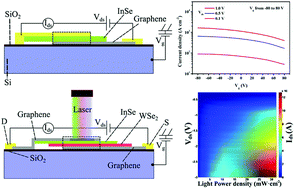Out of plane stacking of InSe-based heterostructures towards high performance electronic and optoelectronic devices using a graphene electrode†
Abstract
Due to their tailored energy band alignments, the integration of two-dimensional materials with out of plane stacking structures provides unprecedented opportunities to fabricate novel electronic and optoelectronic devices. Here, we report the vertical integration of Au–InSe–graphene and graphene–InSe/WSe2–graphene heterostructures to achieve superior properties. The InSe/graphene heterostructure shows a large current density up to 1646 A cm−2, which makes it a potential candidate for high current flexible devices to enable three dimensional integration. Meanwhile, the graphene–InSe/WSe2–graphene heterostructure exhibits a high rectification ratio of 103, a decent responsivity of 83 A W−1, and a superior detectivity of 1.55 × 1012 Jones, simultaneously. Theoretical calculation indicates that the superior device performance can be attributed to the type II band alignment of InSe and WSe2, which enables efficient separation of photo-generated electron–hole pairs. This study paves the way for the facile fabrication of various functional heterostructures for next-generation electronic and optoelectronic applications.



 Please wait while we load your content...
Please wait while we load your content...